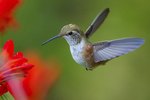Adult Fly Copulation
The female fly typically only mates once during her life, thus she considered monogamous. The sperm received from the male fly during their only copulation moves into a storage area located in the female fly's reproductive system called the spermatheca. This sperm storage area is accessed repeatedly by several batches of eggs that the female lays throughout her lifetime as the eggs pass down the oviduct. The male fly has genitalia located on its posterior, which are withdrawn when not mating. The female also has posterior sex organs, her segmented ovipositor can be retracted or extended to allow her to lay eggs. The female attracts a male by producing muscalure, a volatile sex pheromone. The complex lobes of the male fly's genitalia clasp onto the female's ovipositor during copulation and the sperm are injected into the female reproductive system. While the male may grasp the female fly in the air, actual copulation takes place on a solid surface.
Eggs, Larvae, Pupa Stages
The female fly can lay several batches of up to 150 fertilized eggs at a time during her life, beginning 3 to 4 days after copulation if temperatures are warm enough. The female lays her eggs in manure or other decaying, moist, organic matter. One female fly can lay up to 1,000 eggs during her lifetime. Each egg is about one millimeter long. The eggs hatch in about 12 hours into white, maggots that look something like small worms. The maggots eat and grow to a length of about 12.5 millimeters within about six day and then burrow down into the organic matter to pupate.
Adult Emerges From Pupa
An adult fly should emerge fully formed from each pupa in 5 to 6 days if the weather is warm or in about one month if the weather is cold. When the adult fly emerges, metamorphosis is complete; the fly has passed through four stages of development. The newly emerged fly is ready to procreate and begin building the next generation of flies. When temperatures are warm, at least one generation of flies can be produced each month. The four stages of the fly's life cycle take between 10 and 21 days, although a female can live for about 75 days.
Resources
Photo Credits
-
http://www.flickr.com/photos/11304375@N07/2992496261/
Writer Bio
Julia Fuller began her professional writing career eight years ago covering special-needs adoption. She holds a bachelor's degree in accounting from Marywood College, is co-owner of GJF Rental Properties as well as a livestock and grain crop farm. She worked for the United States Postal Service and a national income tax service.




